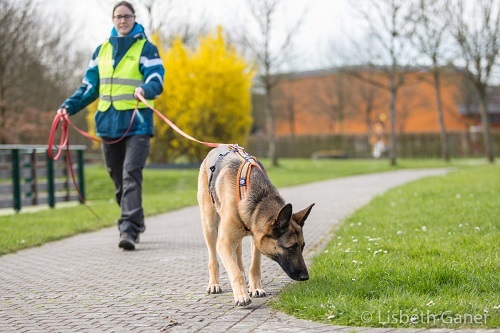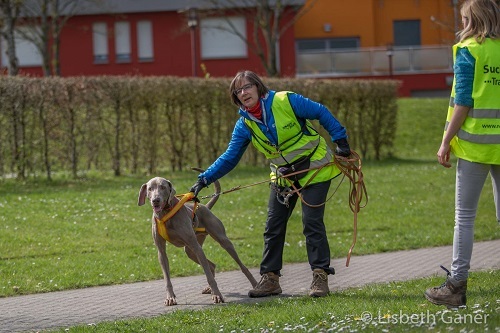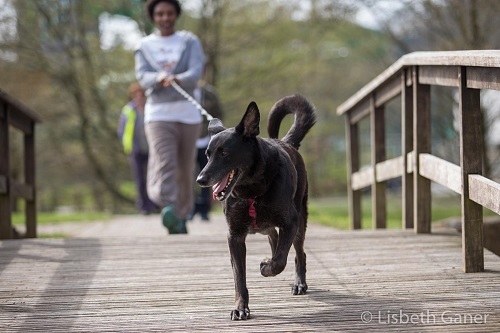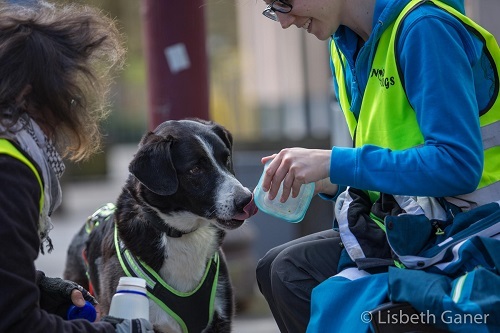A few years ago I was reading a mystery novel where a child was lost in the woods, and search and rescue dogs were used to find her. I know that the police and military use dogs on the force, however, this was the first time that I was formally introduced to these practices. It got me thinking about my German Shepard, McKayla, and wondered if she would enjoy this type of training. Even though the book was fiction, I was eager to learn more about the benefits and search for an establishment where McKayla and I could learn together.
I interviewed two entities in Luxembourg that offer this type of expertise. The first is the Luxembourg Red Cross Rescue Dog Team (LRCRDT), an official organization and part of the Red Cross that offers rigorous training to individuals and their dogs to learn how to save lives. The second is Nosey Dogs, which offers the whole pallet of nosework training, and is as enjoyable and educational activity that provides a bonding experience for dogs and owners.
The LRCRDT was founded in April 1996 by Jerry Ast. His goal was to establish a well-trained team of dogs and handlers that would work together to save people's lives. During the first year they had difficulty overcoming the perception that such a team would not be efficient. It took a lot of hard work, dedication, and consistency by the individuals, the dogs, and their leader, but the group was able to change this mindset and establish the solid reputation that they still have today.
The LRCRDT consists of 28 people and 21 dogs. 12 of the dogs are certified, 11 are questing dogs that search for missing people, and 3 are also certified in searching for living people among debris. One dog is a so called "mantrailer" searching for people based on their individual odor. The remaining people are so-called "potential victims" for the training and do a lot of other work in the team. The dogs vary in breed type and currently consist of Labrador Retriever, Flat Coated Retriever, Border Collie, Australian Shepherd, German Shepherd, Belgium Shepherd (Malinois), Dutch Shepherd, Briard, and Mixtures. When I asked Jerry if there are any breeds that typically perform better than another he replied,
"It is clear that even inside one breed, there are better and less good dogs. What is Important for us is that the dog has on one side a long nose (number of olfactory cells is very important), and on the other side the dog must have the necessary motivation to work: a good performed play-instinct and prey-instinct is the 'conditio sine qua non.' Breeds that are listed in our national dog laws are not allowed to join the group."
Typically in a calendar year the team is asked to perform about 15 searches for missing people. Sometimes there are calls for intervention in debris environments, but these are generally the exceptions. The handlers generally have professions of all sorts and are working normal business hours, and since an intervention can occur at any time, the team members must organize themselves to leave work and report to the scene as soon as possible. On average the team provides 12 - 15 handlers plus dogs when called to conduct a search.
Besides searching for missing people, the team is trained to conduct search and rescue after earthquakes or other natural disasters within a 5,000 kilometer range of Luxembourg. The team also assists with searches outside of Luxembourg, and over the years has conducted earthquake interventions in Algeria (2003), Iran (2003), Morocco (2004) and Haiti (2010). When asked, "What was the most difficult disaster aftermath to conduct a search in and why," Jerry replied:
"Every catastrophe is difficult for conducting search and rescue and every catastrophe is specific. The greatest problem in those cases is the time factor. Every hour that passes costs lives. There are a lot of factors that influence such interventions; communication, coordination, transportation are just a few."
Up to this point, you may be thinking that becoming trained in search and rescue seems exciting and something that you're ready to go out and do. What many fail to realize is the amount of time, dedication, and loyalty required that tends to deter people and weed out those that are not ready to give up their free time from those who are truly committed.
There are many requirements that the dogs and handlers much achieve and examinations that they must both pass in order to become certified. As Jerry explained,
Dog Handler Requirements
1. The handler must detain a valid 1st aid certificate to join the team.
2. The handler is trained in radio-communication, orientation inclusive GPS, structure of debris, intervention tactics on debris and in the field, first aid on the dog, paramedic-training, cynologie, transport of the dogs, safety in interventions, organization and intervention tactic man-trailing, knowledge and use of the intervention materials on board of the teams intervention-vehicles.
3. The dog has to present a real interest in working and a good performed play-instinct and prey-instinct, have a good relationship to other dogs and his handler, and must be fully operational that year.
Examinations for the dog
4. A first test of behavior and reactions on different environmental effects (allows the beginning of the training).
5. After about two years training, the dog should be ready to test for the first certification (obedience, agility, questing, search on debris). The dog must be re-certified every two years.
Examinations for the Handler
6. After one year the handler can test for assistant certification (theoretical exam, first aid, orientation and knowledge of the intervention vehicles);
7. The handler is then tested with the dog in the following areas: a) Obedience, b) Agility, c) Questing examination where the handler has to guide his dog, communication with coordination center, GPS information, first aid on the victim found by his dog, d) Search on debris.
Typically it takes about two years to complete the normal basic training until the first certification is achieved. Afterwards, the dog and handler must pass a re-certification every two years. The team has training sessions twice a week lasting between three and five hours each time depending on the number of dogs present that day. It is a mandatory requirement that every member of the team is present during the entire training session and not just during the time that their dog is working. There is no monetary cost to join the team and train, however, the handler is responsible for their own dog and must support all of food, veterinary expenses, and whatever else is needed to maintain healthy and happy pets. The organization only pays veterinary cost in case of an accident during training or intervention, and the dog must always be kept up to date with all required vaccinations.
The LRCRDT is a real life-saving organization. It is not a game and not to be taken lightly. Some people initially want to try it out thinking that attributing minimal time and effort will be accepted, but soon find out that this attitude is not tolerated. With this in mind, I asked Jerry if it is difficult to find loyal and dedicated team members due to the amount of training and time required. He replied,
"Let's say that first people must have a real interest in rescue and paramedic and love to combine this with the work of the dog. It is not the quantity but the quality of the members that is important. During the last 20 years we did not have too much problems to get new members."
As the founder of the team and the dedicated force keeping the operation growing and moving forward, I asked Jerry what he loves most about performing search and rescue operations and why.
"It is not a question of love. It is the question of doing as a volunteer a professional job because it doesn't matter much to our victim if I am a professional or a volunteer. The only important thing is to localize and rescue her till she is alive! Searching and saving people together with a 'four-wheeled' friend and partner is a brilliant combination between doing something important and useful."
As someone interested in pursuing this training in the future, I was intrigued to hear Jerry's advice for people who are considering becoming trained in professional search and rescue.
"First of all do not be an egoist! Secondly, have a lot of time for training and missions. Third, like to work in a team and not as an individualist."
Our German Shepard, McKayla, would have been well suited for search and rescue training, but as she is now almost 9 years old, it is too late for her to start. However, there is an alternative that offers nosework training to dogs of all ages as a fun activity in a less demanding environment.
Jacqueline and Michaela founded Nosey Dogs together in 2012, first in Germany, and then expanded to Luxembourg in 2015. The school offers the whole pallet of nosework, for example mantrailing, scent discrimination, dummy work. At the moment their main focus is mantrailing (the dog follows a human trail), and scent discrimination. There might be a situation where the owner of the dog is allergic to peanuts, and through sent discrimination training the dog can learn to detect if peanuts are contained in the meal.
There is no prior experience or training in nosework that is required for the dog or handler to join their classes. If the dog is well trained in general obedience that is a plus, but puppies are also welcome. With regards to breed type they believe that every dog can do his job as long as he can smell. Of course some dogs are predestined, but every breed is capable and the strongest argument is the species-appropriate work since every dog has a hunting instinct that may be more or less developed. The main limiting factor could be the health and physical fitness of the dog.
While conducting their classes their philosophical approach is based on a stressless learning process through positive reinforcement for dog and handler. Both partners in the team should have fun and enjoy "the hunting" they do together which in turn strengthens their relationship. Nosey Dogs' goal is to teach their experience to the teams.
In order to provide the most optimum experience to their clients, both women have and continue to diligently study and receive training to increase their level of education in this field. Click Here to Continue Reading on Petopia's Blog, Zoe's Couch




